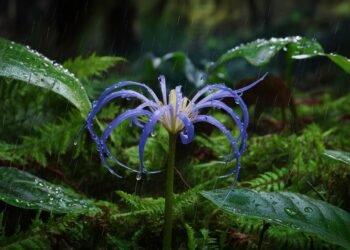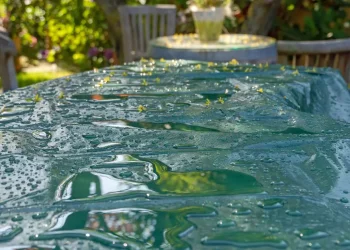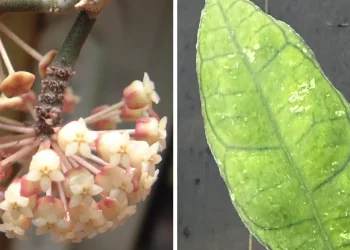If you’ve been on a journey to create a healthier home environment, there’s one aspect you shouldn’t overlook – indoor air quality. It’s the silent but crucial factor that can significantly impact your well-being.
But how do you address that? On the market, there are hundreds of different air purifiers with modern design and features. Or you can get a Hoya plant.
Hoya?! Yes!
You’ve probably heard that some plants supposedly have the ability to purify the air. One of these plants is believed to be Hoya.
Hoya, commonly known as wax plant, is a tropical plant originating from tropical and subtropical regions of Asia and Australia. Many gardeners love this plant, especially for its flowers, which create beautiful star patterns. And if this plant truly has the superpower to purify the air around, I am in! But does hoya really live up to the hype?
Well, Hoya really has the ability to purify the air. But how effective is it? And is it enough to be your only tool for healthier air around?
For this article, I’ve reviewed all the available research to find some answers. We’ll explore how it works, its real impact on your indoor environment, and I will share other practical insights you can use to create a healthier living space. Let’s dive in!
Understanding Indoor Air Pollution
We tend to think that air pollution is something we face only outside, from outdoor sources. Smoke from factories, wildfires, etc., really does affect air quality.
But the air we breathe indoors can also be polluted, and not only from these sources. Common indoor air pollutants, such as volatile organic compounds (VOCs), dust, and allergens, can silently infiltrate our living spaces.
VOCs are often emitted by household products like paints and cleaning agents. Dust and allergens, like pollen and pet dander, can accumulate over time, further compromising the air we breathe.
Human activities can be a source of pollutants, furniture around you emits vapors, not to talk about mold or viruses. All these and other things affect the air we breathe.
The implications of poor indoor air quality on our health are profound, ranging from aggravating respiratory conditions to triggering allergies and even impacting our overall well-being.
Under normal circumstances, the average indoor air quality, if you are healthy, doesn’t posses any extraordinary risks. But that doesn’t mean that purifying the air around you isn’t beneficial, it is. It can help you combat allergies or improve your quality of sleep.
Does Hoya Purify Air?
Yes, Hoya really has the ability to purify air. Research has found that Hoya is proficient at removing common indoor pollutants such as formaldehyde, benzene, and xylene from the air.
Researchers took 28 common indoor plants, including Hoya Carnosa (the most common Hoya variety), and tested their abilities to purify indoor pollutants within 6 hours.
Hoya, with its purifying skills, outranked 24 of them. But that essentially means nothing else than that Hoya is very effective in purifying air among other plants. But is it really effective in comparison to modern electronic purifiers?
How Effective is Hoya at Purifying Air?
It’s hard to compare the effectiveness of plants in purifying air with air cleaning devices, as neither the Food and Drug Administration (FDA) nor the Environmental Protection Agency (EPA) certify them, so it’s challenging to find comparable results. Additionally, it’s not really comparable, as air purifiers are designed to clean the air off even the tiniest particles, whereas Hoya nor other plants have the ability to clean, for instance, viruses or molecules from the air. Or, to rephrase that, plants can clean the air of gaseous pollutants, but not solid particles like viruses and bacteria.
For that reason, I’d like you to view Hoya and other plants as supplementary tools for purifying air. As their use really ends there.
But just out of curiosity, let’s compare the effectiveness of the Hoya plant against the air purifier.
In terms of the removal of benzene from the air – benzene is a common component in cleaning products, paint, or tobacco smoke, we can see a notable disparity.
The efficiency of Hoya carnosa in reducing benzene levels is roughly 6.93% in 6 hours. In contrast, the air purifier performed incomparably better, swiftly reducing benzene levels by 85% after only 15 minutes of operation and achieving a 95% reduction after 1.5 hours.
The two studies I used: EOLIS & Screening Indoor Plants for Volatile Organic Pollutant Removal Efficiency
How does Hoya Purify Air?
Hoya’s air-purifying prowess lies in a natural process known as phytoremediation.
When exposed to airborne contaminants like benzene or toluene, Hoya deploys its lush green leaves and intricate root system to take action.
The plant absorbs these pollutants through tiny openings in its leaves called stomata and, subsequently, through its root cells. Once inside the plant, these pollutants are broken down or stored, effectively reducing their concentration in the air.
Conclusion
Hoya really can help purify the air around. However, hoya’s ability, or in general plants’ ability to purify air is really limited.
For starters, plants are not able to clean all the pollutants from the air, their primary use is for gases, so they won’t be able to get viruses or bacteria out of the air to a higher extent. Secondly, as the study shows, their efficiency for benzene removal is roughly 6.93%, and benzene is the most common gas found indoors, commonly vaporizing from various cleaning products.
That’s why the primary function of plants is still to make you happy. Their purifying effects are great, just as an added bonus.











